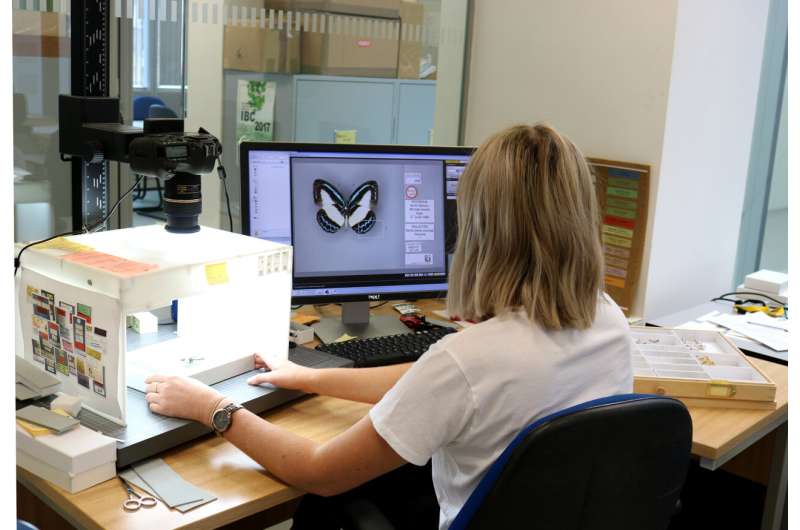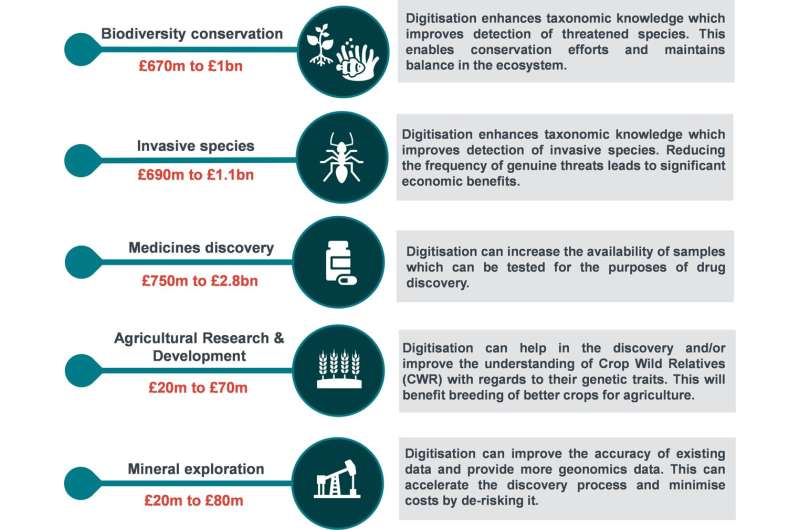Digitizing the Natural History Museum London's entire collection could contribute over £2 billion to the global economy

The societal benefits of digitizing natural history collections extends to global advancements in food security, biodiversity conservation, medicine discovery, minerals exploration, and beyond. Brand new, rigorous economic report predicts investing in digitizing natural history museum collections could also result in a tenfold return. The Natural History Museum, London, has so far made over 4.9 million digitized specimens available freely online - over 28 billion records have been downloaded over 429,000 download events over the past six years.
Digitisation at the Natural History Museum, London
Digitisation is the process of creating and sharing the data associated with Museum specimens. To digitize a specimen, all its related information is added to an online database. This typically includes where and when it was collected and who found it, and can include photographs, scans and other molecular data if available. Natural history collections are a unique record of biodiversity dating back hundreds of years, and geodiversity dating back millennia. Creating and sharing data this way enables science that would have otherwise been impossible, and we accelerate the rate at which important discoveries are made from our collections.
The Natural History Museum's collection of 80 million items is one of the largest and most historically and geographically diverse in the world. By unlocking the collection online, the Museum provides free and open access for global researchers, scientists, artists and more. Since 2015, the Museum has made 4.9 million specimens available on the Museum's Data Portal, which have seen more than 28 billion downloads over 427,000 download events.
This means the Museum has digitized about 6% of its collections to date. Because digitisation is expensive, costing tens of millions of pounds, it is difficult to make a case for further investment without better understanding the value of this digitisation and its benefits.
In 2021, the Museum decided to explore the economic impacts of collections data in more depth, and commissioned Frontier Economics to undertake modeling, resulting in this project report, now made publicly available in the open-science journal Research Ideas and Outcomes (RIO Journal), and confirming benefits in excess of £2 billion over 30 years. While the methods in this report are relevant to collections globally, this modeling focuses on benefits to the UK, and is intended to support the Museum's own digitisation work, as well as a current scoping study funded by the Arts & Humanities Research Council about the case for digitizing all UK natural science collections as a research infrastructure.
Sharing data from our collections can transform scientific research and help find solutions for nature and from nature. Our digitized collections have helped establish the baseline plant biodiversity in the Amazon, find wheat crops that are more resilient to climate change and support research into potential zoonotic origins of Covid-19. The research that comes from sharing our specimens has immense potential to transform our world and help both people and the planet thrive, says Helen Hardy, Science Digital Programme Manager at the Natural History Museum.

How digitisation impacts scientific research?
The data from museum collections accelerates scientific research, which in turn creates benefits for society and the economy across a wide range of sectors. Frontier Economics Ltd have looked at the impact of collections data in five of these sectors: biodiversity conservation, invasive species, medicines discovery, agricultural research and development and mineral exploration.
Dan Popov, Economist at Frontier Economics Ltd, says that "the Natural History Museum's collection is a real treasure trove which, if made easily accessible to scientists all over the world through digitisation, has the potential to unlock ground-breaking research in any number of areas. Predicting exactly how the data will be used in future is clearly very uncertain. We have looked at the potential value that new research could create in just five areas focussing on a relatively narrow set of outcomes. We find that the value at stake is extremely large, running into billions."
The new analyses attempt to estimate the economic value of these benefits using a range of approaches, with the results in broad agreement that the benefits of digitisation are at least ten times greater than the costs. This represents a compelling case for investment in museum digital infrastructure without which the many benefits will not be realized.
Professor Ken Norris, Head of the Life Sciences Department at the Natural History Museum says that: "This new analysis shows that the data locked up in our collections has significant societal and economic value, but we need investment to help us release it."
Other benefits could include improvements to the resilience of agricultural crops by better understanding their wild relatives, research into invasive species which can cause significant damage to ecosystems and crops, and improving the accuracy of mining.
Finally, there are other impacts that such work could have on how science is conducted itself. The very act of digitizing specimens means that researchers anywhere on the planet can access these collections, saving time and money that may have been spent as scientists traveled to see specific objects.
More information: Danail Popov et al, The Value of Digitising Natural History Collections, Research Ideas and Outcomes (2021). DOI: 10.3897/rio.7.e78844
Provided by Pensoft Publishers




















